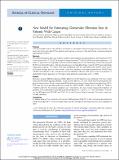Files in this item
New model for estimating glomerular filtration rate in patients with cancer
Item metadata
| dc.contributor.author | Janowitz, Tobias | |
| dc.contributor.author | Williams, Edward H. | |
| dc.contributor.author | Marshall, Andrea | |
| dc.contributor.author | Ainsworth, Nicola | |
| dc.contributor.author | Thomas, Peter B. | |
| dc.contributor.author | Sammut, Stephen J. | |
| dc.contributor.author | Shepherd, Scott | |
| dc.contributor.author | White, Jeff | |
| dc.contributor.author | Mark, Patrick B. | |
| dc.contributor.author | Lynch, Andy G. | |
| dc.contributor.author | Jodrell, Duncan I. | |
| dc.contributor.author | Tavaré, Simon | |
| dc.contributor.author | Earl, Helena | |
| dc.date.accessioned | 2017-08-11T14:30:09Z | |
| dc.date.available | 2017-08-11T14:30:09Z | |
| dc.date.issued | 2017-08 | |
| dc.identifier | 250731180 | |
| dc.identifier | 70feb42e-6160-4f0e-a0d9-4885a9431c35 | |
| dc.identifier | 28686534 | |
| dc.identifier | 85028510283 | |
| dc.identifier.citation | Janowitz , T , Williams , E H , Marshall , A , Ainsworth , N , Thomas , P B , Sammut , S J , Shepherd , S , White , J , Mark , P B , Lynch , A G , Jodrell , D I , Tavaré , S & Earl , H 2017 , ' New model for estimating glomerular filtration rate in patients with cancer ' , Journal of Clinical Oncology , vol. 35 , no. 24 , pp. 2798-2805 . https://doi.org/10.1200/JCO.2017.72.7578 | en |
| dc.identifier.issn | 0732-183X | |
| dc.identifier.other | RIS: urn:33EB7EB9D8B999228B23C9AB29936716 | |
| dc.identifier.other | ORCID: /0000-0002-7876-7338/work/35946866 | |
| dc.identifier.uri | https://hdl.handle.net/10023/11432 | |
| dc.description | T.J. was supported by the Wellcome Trust Translational Medicine and Therapeutics Programme and the University of Cambridge, Department of Oncology (RJAG/076). H.E. was supported by the National Institute of Health Research Cambridge Biomedical Research Centre and the University of Cambridge. | en |
| dc.description.abstract | Purpose: The glomerular filtration rate (GFR) is essential for carboplatin chemotherapy dosing; however, the best method to estimate GFR in patients with cancer is unknown. We identify the most accurate and least biased method. Methods: We obtained data on age, sex, height, weight, serum creatinine concentrations, and results for GFR from chromium-51 (51Cr) EDTA excretion measurements (51Cr-EDTA GFR) from white patients ≥ 18 years of age with histologically confirmed cancer diagnoses at the Cambridge University Hospital NHS Trust, United Kingdom. We developed a new multivariable linear model for GFR using statistical regression analysis. 51Cr-EDTA GFR was compared with the estimated GFR (eGFR) from seven published models and our new model, using the statistics root-mean-squared-error (RMSE) and median residual and on an internal and external validation data set. We performed a comparison of carboplatin dosing accuracy on the basis of an absolute percentage error > 20%. Results: Between August 2006 and January 2013, data from 2,471 patients were obtained. The new model improved the eGFR accuracy (RMSE, 15.00 mL/min; 95% CI, 14.12 to 16.00 mL/min) compared with all published models. Body surface area (BSA)?adjusted chronic kidney disease epidemiology (CKD-EPI) was the most accurate published model for eGFR (RMSE, 16.30 mL/min; 95% CI, 15.34 to 17.38 mL/min) for the internal validation set. Importantly, the new model reduced the fraction of patients with a carboplatin dose absolute percentage error > 20% to 14.17% in contrast to 18.62% for the BSA-adjusted CKD-EPI and 25.51% for the Cockcroft-Gault formula. The results were externally validated. Conclusion: In a large data set from patients with cancer, BSA-adjusted CKD-EPI is the most accurate published model to predict GFR. The new model improves this estimation and may present a new standard of care. | |
| dc.format.extent | 10 | |
| dc.format.extent | 1045338 | |
| dc.language.iso | eng | |
| dc.relation.ispartof | Journal of Clinical Oncology | en |
| dc.subject | RC0254 Neoplasms. Tumors. Oncology (including Cancer) | en |
| dc.subject | DAS | en |
| dc.subject | SDG 3 - Good Health and Well-being | en |
| dc.subject.lcc | RC0254 | en |
| dc.title | New model for estimating glomerular filtration rate in patients with cancer | en |
| dc.type | Journal article | en |
| dc.contributor.institution | University of St Andrews. School of Medicine | en |
| dc.contributor.institution | University of St Andrews. Statistics | en |
| dc.contributor.institution | University of St Andrews. Cellular Medicine Division | en |
| dc.identifier.doi | https://doi.org/10.1200/JCO.2017.72.7578 | |
| dc.description.status | Peer reviewed | en |
This item appears in the following Collection(s)
Items in the St Andrews Research Repository are protected by copyright, with all rights reserved, unless otherwise indicated.

